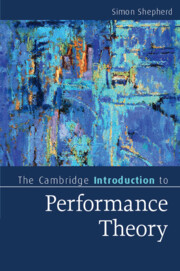Book contents
- Frontmatter
- Contents
- Preface
- Part I Definitions of performance
- Part II The emergence of performance as sensuous practice
- 6 Situationism, games and subversion
- 7 Hippies and expressive play
- 8 Performance as a new pedagogy
- 9 Architecture and the performed city
- 10 New forms of activism
- 11 Happenings and everyday performance
- 12 Body art and feminism
- 13 The arrival of Performance Art and Live Art
- 14 Dance party politics
- Part III Theorising performance
- Closing note
- References
- Index
- Cambridge Introductions to …
13 - The arrival of Performance Art and Live Art
from Part II - The emergence of performance as sensuous practice
Published online by Cambridge University Press: 05 February 2016
- Frontmatter
- Contents
- Preface
- Part I Definitions of performance
- Part II The emergence of performance as sensuous practice
- 6 Situationism, games and subversion
- 7 Hippies and expressive play
- 8 Performance as a new pedagogy
- 9 Architecture and the performed city
- 10 New forms of activism
- 11 Happenings and everyday performance
- 12 Body art and feminism
- 13 The arrival of Performance Art and Live Art
- 14 Dance party politics
- Part III Theorising performance
- Closing note
- References
- Index
- Cambridge Introductions to …
Summary
The more surprising it is, then, that feminism does not appear in the index of one of the most influential accounts of the history of body or performance art, RoseLee Goldberg's Performance: Live Art 1909 to the Present. Just as the histories of happenings positioned them conceptually, so too it was for what became known by many as ‘Performance’, now with a capital P, or Live Art, also a capital affair.
Claiming a heritage
Next to nothing has done this positioning more influentially than Goldberg's Performance, which has been reprinted several times since its first publication in 1979, with additional material and a slightly reworked preface. When it appeared it was a pioneering attempt to marshal a great body of diverse material into one place, thereby offering a way of making sense of it, and it begins by announcing a watershed moment: ‘Performance has only recently become accepted as a medium of artistic expression in its own right.’ That acceptance has meant that what had been a ‘hidden history’ can now be comprehensively reviewed. In discovering the hidden history it becomes clear that ‘artists have always turned to live performance as one means among many of expressing their ideas.’ A characteristic of this expressive medium is that ‘Live gestures have constantly been used as a weapon against the conventions of established art.’ This claim ties in with the first chapter's topic, the Futurists and their calls to ‘go out into the street, launch assaults from theatres’. But Goldberg is clear that this ‘hidden history’ begins well before Futurism and includes ‘tribal ritual or medieval Passion plays, Leonardo da Vinci's experiments before invited audiences or his river pageants, Bernini's staged spectacles’. In the twentieth century, ‘Performance manifestos, from the Futurists to the present, have been the expression of dissidents … Performance has been a way of appealing directly to a large public, as well as shocking audiences into reassessing their own notions of art and its relation to culture. For this reason its base has always been anarchic. Moreover, by its very nature, performance defies precise or easy definition beyond the single declaration that it is live art by artists’ (1979: 6, 12; my elision).
While she quite properly admits the slipperiness of the term of which she is trying to write the modern history, this slipperiness is somewhat lubricated by the foreword.
- Type
- Chapter
- Information
- The Cambridge Introduction to Performance Theory , pp. 122 - 131Publisher: Cambridge University PressPrint publication year: 2016



